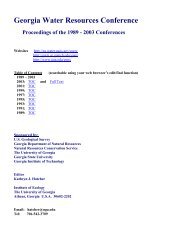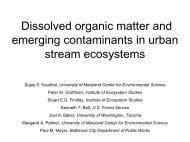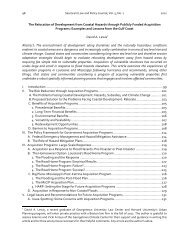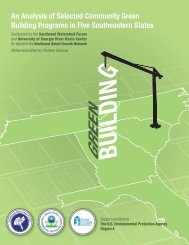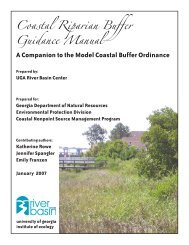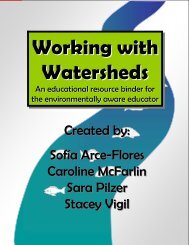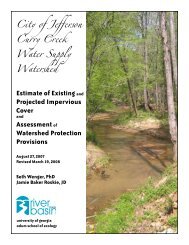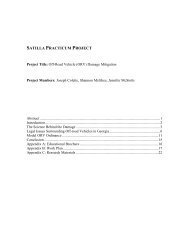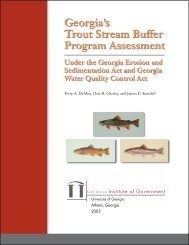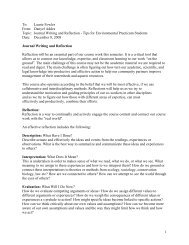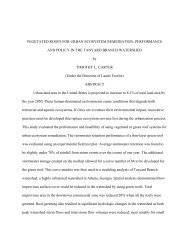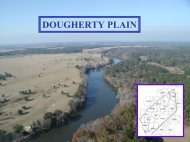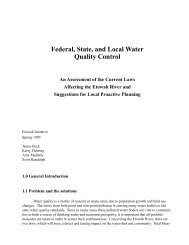1 Bibliographic Review of Sources Relevant to Development of Draft ...
1 Bibliographic Review of Sources Relevant to Development of Draft ...
1 Bibliographic Review of Sources Relevant to Development of Draft ...
Create successful ePaper yourself
Turn your PDF publications into a flip-book with our unique Google optimized e-Paper software.
Savannah River Annotated Bibliography: January 2003<br />
and Management 90(2,3): 237-250.<br />
Megonigal, J., W. Conner, S. Kroeger and R. Sharitz (1997). "Aboveground production<br />
in southeastern floodplain forests: a test <strong>of</strong> the subsidy-stress hypothesis."<br />
Ecology 78(2): 370-384.<br />
Paired plots were established across a soil moisture gradient (dry, periodically flooded, flooded) in<br />
three forested wetland watersheds in Louisiana, and South Carolina. The SC sites included one on<br />
the Savannah River and one on Upper Three Runs Creek, a tributary. All trees greater than 10 cm<br />
diameter at breast height were tagged and measured annually. The greatest changes in density<br />
occurred in those sites where water-level changes were occurring or where winds<strong>to</strong>rms struck.<br />
Mortality rates are typically low in areas that have not been altered hydrologically. Flooded sites<br />
in both states had the greatest basal area, and dry and periodically flooded sites had similar basal<br />
areas.<br />
Effects <strong>of</strong> river flow management on floodplain systems<br />
Dudgeon, D. (1995). "River Regulation in Southern China - Ecological Implications,<br />
Conservation and Environmental-Management." Regulated Rivers-Research &<br />
Management 11(1): 35-54.<br />
The importance <strong>of</strong> floods as an incentive for river regulation is apparent from the fact that 10% <strong>of</strong><br />
China's area, inhabited by 65% <strong>of</strong> the population and responsible for 70% <strong>of</strong> the agricultural and<br />
industrial output, is below the flood level <strong>of</strong> major rivers. Large-scale water-transfer projects and<br />
the planned construction <strong>of</strong> the biggest dam in the world (the Three Gorges High Dam) on the<br />
Chang Jiang have the potential <strong>to</strong> affect fisheries s<strong>to</strong>cks and endangered fish species, <strong>to</strong> alter<br />
inundation patterns in wetlands <strong>of</strong> international conservation significance and may contribute <strong>to</strong><br />
the extinction <strong>of</strong> the endemic and highly endangered Chinese alliga<strong>to</strong>r (Alliga<strong>to</strong>r sinensis) and<br />
Chinese river dolphin (Lipotes vexillifer). In addition, deforestation and soil erosion in the Chang<br />
Jiang basin have given rise <strong>to</strong> siltation and degradation <strong>of</strong> floodplain habitats. In the Zhujiang,<br />
dam construction has caused reductions in fisheries s<strong>to</strong>cks but here, as elsewhere in China, the<br />
ecologically damaging consequences <strong>of</strong> river regulation are exacerbated by overfishing and<br />
increasing pollution <strong>of</strong> rivers by sewage, pesticides and industrial wastes.<br />
Kingsford, R. T. (2000). "Ecological impacts <strong>of</strong> dams, water diversions and river<br />
management on floodplain wetlands in Australia." Austral Ecology 25(2): 109-<br />
127.<br />
Australian floodplain wetlands are sites <strong>of</strong> high biodiversity that depend on flows from rivers.<br />
Dams, diversions and river management have reduced flooding <strong>to</strong> these wetlands, altering their<br />
ecology, and causing the death or poor health <strong>of</strong> aquatic biota. Four floodplain wetlands (Barmah-<br />
Millewa Forest and Moira Marshes, Chowilla floodplain, Macquarie Marshes, Gwydir wetlands)<br />
illustrate these effects with successional changes in aquatic vegetation, reduced vegetation health,<br />
declining numbers <strong>of</strong> water birds and nesting, and declining native fish and invertebrate<br />
populations. Plans exist <strong>to</strong> build dams <strong>to</strong> divert water from many rivers, mainly for irrigation.<br />
These plans seldom adequately model subsequent ecological and hydrological impacts <strong>to</strong><br />
floodplain wetlands. To avoid further loss <strong>of</strong> wetlands, an improved understanding <strong>of</strong> the<br />
interaction between river flows and floodplain ecology, and investigations in<strong>to</strong> ecological impacts<br />
<strong>of</strong> management practices, is essential.<br />
Nilsson, C. and K. Berggren (2000). "Alterations <strong>of</strong> riparian ecosystems caused by river<br />
regulation." Bioscience 50(9): 783-792.<br />
20



